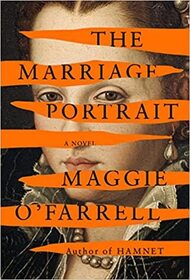Helpful Score: 2
But For An Heir
Robert Browning's poem, "The Last Duchess" is based on a portrait he saw of Lucrezia de' Medici, a young girl from Florence during the Renaissance, married off at 13 and dead by 17. History records that she died of tuberculosis, yet there have always been the rumors she was murdered by her husband, Duke Alfonso,
Maggie O'Farrell takes this character and enriches her background. As "The Marriage Portrait" opens in 1561, we find Lucrezia fearing for her life, convinced Alfonso has attempted to poison her. We backtrack to her youth, growing up fairly invisible in a large wealthy family. As a middle child out of twelve, not much was expected of her until an older sister died and she was chosen to take her place in the engagement to a Duke. Her entire worth is now defined in her ability to bear a son, an heir to the Duke of Ferrara.
Alfonso enters the story as a charming, sensitive man and he gives Lucrezia all the attention and freedoms she never had in her sheltered upbringing. It does not take long, however, for his cruel and ruthless side to erupt. Whatever affection he had for Lucrezia completely dissipates when his political agenda is challenged.
Lucrezia is a marvel in these pages. She had always kept to herself while fighting hard to blossom within. As a child she sought out the caged tiger her father brought to Florence. She developed her painting skills in a somewhat secretive manner, painting over work that only she could know. At the very onset of the book she is faced with the attempt on her life and, although panicking, she does not back down. This is a young woman, still in her teens, who defies the power which would claim her life. Maggie O'Farrell has conjured up a rich, exciting life force of the nearly forgotten Lucrezia de'Medici, refusing to keep her hiding as a footnote to history.
I received an advance review copy for free, and I am leaving this review voluntarily.
Robert Browning's poem, "The Last Duchess" is based on a portrait he saw of Lucrezia de' Medici, a young girl from Florence during the Renaissance, married off at 13 and dead by 17. History records that she died of tuberculosis, yet there have always been the rumors she was murdered by her husband, Duke Alfonso,
Maggie O'Farrell takes this character and enriches her background. As "The Marriage Portrait" opens in 1561, we find Lucrezia fearing for her life, convinced Alfonso has attempted to poison her. We backtrack to her youth, growing up fairly invisible in a large wealthy family. As a middle child out of twelve, not much was expected of her until an older sister died and she was chosen to take her place in the engagement to a Duke. Her entire worth is now defined in her ability to bear a son, an heir to the Duke of Ferrara.
Alfonso enters the story as a charming, sensitive man and he gives Lucrezia all the attention and freedoms she never had in her sheltered upbringing. It does not take long, however, for his cruel and ruthless side to erupt. Whatever affection he had for Lucrezia completely dissipates when his political agenda is challenged.
Lucrezia is a marvel in these pages. She had always kept to herself while fighting hard to blossom within. As a child she sought out the caged tiger her father brought to Florence. She developed her painting skills in a somewhat secretive manner, painting over work that only she could know. At the very onset of the book she is faced with the attempt on her life and, although panicking, she does not back down. This is a young woman, still in her teens, who defies the power which would claim her life. Maggie O'Farrell has conjured up a rich, exciting life force of the nearly forgotten Lucrezia de'Medici, refusing to keep her hiding as a footnote to history.
I received an advance review copy for free, and I am leaving this review voluntarily.




